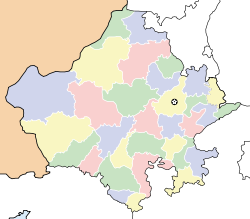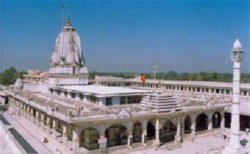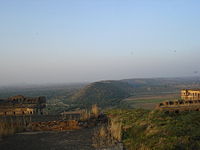- Tijara
-
Tijara — city — Coordinates 27°56′N 76°51′E / 27.93°N 76.85°ECoordinates: 27°56′N 76°51′E / 27.93°N 76.85°E Country India State Rajasthan District(s) Alwar Population 19,918 (2001[update]) Time zone IST (UTC+05:30) Area
• 291 metres (955 ft)
Tijara is a city and a municipality in Alwar district in the Indian state of Rajasthan. Tijara is situated 48 km to the north east of Alwar, the nearest Railwau station is Khairthal. It was founded by Tajpala, Raja of Sarahata, 6 km from Tijara. A scion of Yadav family, he built palaces at Tijara . His descendant Bhadur Nahar accepted Islam in the 14th c. and became famous by the name of Khanzada. [1][2] Till today tijara is dominated by Yadavs and Meos.[3]
Contents
Geography
Tijara is located at 27°56′N 76°51′E / 27.93°N 76.85°E.[4] It has an average elevation of 291 metres (954 feet).
Tijara is easily reached from the Daruhera-Alwar road.
Demographics
As of 2001[update] India census,[5] Tijara had a population of 19,918. Males constitute 53% of the population and females 47%. Tijara has an average literacy rate of 62%, higher than the national average of 59.5%: male literacy is 72%, and female literacy is 51%. In Tijara, 18% of the population is under 6 years of age.
History
Tijara is one the most historic place from the Vedic Yug. Name of Tijara was "Trigat Nagar" at the time of RamaYug (SatYug). Shravan passed through TrigatNagar when he was on the journey of Dharshan Of CharDham with his Parents.
The mention of Tijara is found in the book, 'Mirat ul Masaud', which relates how Saiyad Ibrahim Mashhadi Barah Hazari (died 421 AH / 1030 AD), an officer of Sultan Mahmud of Ghazni, in A.H. 420 (A.D. 1030) attacked Dhundgarh near Rewari, the Raja of which fled to his kinsman Tej Pal of Rewari. The latter, in a night attack, killed Saiyad Ibrahim, but his disciple Ghazi Saiyyad Salar Masud compelled Tej Pal to fly to Tijara, where, in a battle, three relatives of Salar were killed. The tombs of some associates of Syed Mohammad Dost (Nana Barah Hazari), Rukn Alam Shaheed, Roshan Shaheed and Bhakan Shaheed in and around the town of Tijara are now places of pilgrimage.[6] Another tomb of the cousin of Saiyad Ibrahim Mashhadi (Barah Hazari), Syed Hameeduddin can also been seen at Kot Qasim (20 km away from Tijara), who was going as injured after the battle of Tijara to Rewari.[7]
A sanad of Akbar's time speaks of "Tijara Shahbad" as though they were the principal towns of a district.[8]
Also in the Ain i Akbari of Mughal King Akbar we have mention of the Khanzadas and a Thathar Rajput tribe living in Tijara where they occupied a brick fort along with 405,108 biggas of land of which the annual revenue was rs 11,906,847. The tribe had 400 cavalry and 2000 infantry soldiers at its disposal.[9]
History bears the testimony of the fact that Dehra -Tijara was a well-developed region. The discovery of the image of Shri 1008 Bhagwan Chandraprabhu in 1956 has a remarkable history.[10]
Hākim-e Shariah Shareef Qazi-e Aazam ibn Qazi Ziauddin of Pinangwan was 'Qazi Qaza' (authority to appoint Qazi) at Tijara. Akbar on 4 Jumada al-Thani 976 AH / 1568 awarded him 2000 Bigha Arazi Swad at Tijara. After him, his son Qazi Mahmood (died 1005 AH / 1596 AD) became the authority to appoint Qazi, similarly, his brother Mohammad Hashim and his son Abdul Hafeez had also received many Farman like Qazi Mahmood. Qazi Ibrahim son of Qazi Mahmood was also 'Qazi Qaza' at Tijara. Shahjahan awarded him Farman first on 22 Dhu al-Hijjah 1054 AH (Juloos 18) and second on 19 Ramadan 1055 AH. Some parts of his ruined haveli is still seen at Tijara. He died on 5 Moharram 1074 AH / 1665 AD. Qazi Abdul Baqi son of Qazi Ibrahim had also close relations with the Durbar of Aurangzeb and had given him charge of appointing 'Qazi' at Tijara. He also built various orchards and Havelis like Haveli Kalan, Deewan Khana, Kothi Bagh,etc. at Tijara. He had business of horses from Arabian breed. The main gates at the Qazi Mohallah were built by him. In the archive of Tahsil Tijara, dated 1070 AH shows the ‘Mafi Bagh’ in the name of Qazi Abdul Baqi.[11]
The city was largerly inhabited by Ahirs since ancient times. Khanzadas Community in large number also lived in this town before partition in 1947. Syed families were mostly inhabited at Qazi Mohalla. Hakim Syed Karam Husain (1870–1953),[12][13] popularly known as Rais-e Tijara (Title used for affluent persons in a particular region), was a famous Unani Physician before partition, also a resident of Qazi Mohalla. He established Dawakhana Shifaul Amraz (a registered Unani pharmaceutics) in 1894, which grew to the extent that the Department of Indian Postal Service had to establish a separate post office for postal distribution of parcels (VPP) at the premises of Dawakhana itself. This exclusive postal service also worked as an additional post office at Tahsil Tijara.[14][15]
In 1956 , the excavation work was taken up for widening of the roads. While digging, a small "Talghar" was found. Late Smt. Saraswati devi w/o Late Biharilal jain discovered an idol on Shravan Shukla Dashmi (16:08:1956). This image bears the date "vaishakh shukla 3,1554 vikram samvat". Later on with the grace of Acharya Shri VimalSagar Ji maharaj, one black idol of Bhagwan chandraprabh was discovered on 29:3:1972.
Historical figures
- Rukn Alam Shaheed (died 1030AD / 421AH)
- Hazrat Shah Ghazi Gadan Shah Walayat (died 1600AD / 1009AH)
- Hazrat Miranji
- Hazrat Shahjeevan Abul Alai (died 1753AD / 1167AH)
- Hazrat Shah Balam
- Hazrat Mirza Ahmad Shah (died 1806AD / 1221AH)
- Khalifa Shah Hamzah Marahrawi (1718–1783)
- Shah Abul Ghais (died 1825AD / 1241AH)
- Qazi Hisamuddin (Mir-e Mohallah Qazi Wada)
Important places
Tijara is of particular relevance to the Jain community. A new addition to an ancient temple is underway.
Beside above you can also visit at ruins of Tijara old fort. Fort is still in good condition. It is very adventorus to visit here and see sunset over green farm land across aravali hills. Localites know these fort by name of 'Suraj Mukee ka Kila". There is one artificial water-dam in between two hills.
Nearby towns
- Ferozepur Jhirka
- Pinangwan
- Mohina
- Jhimrawat - 20 km
- Nuh
- Palwal
- Sakras
- Jhajjar
- Kot Qasim (20 km away from Tijara)
Chronicle or places of memoir
'Tijara House', a beautiful building built in 1955, at Aligarh carries the name of Tijara, and now owns the office of Ibn Sina Academy of Medieval Medicine and Sciences, founded by Hakim Syed Zillur Rahman.
See also
- Ghulam Mansoor
- Munshi Hakimuddin
- Ghulam Ahmad Faroghi
- Hafiz Mazhar Husain
- Qazi Mir Imdad Ali
- Hakim Syed Atiqul Qadir
- Advocate Nasiruddin
- Hakim Syed Fazlur Rahman
- General Fateh Naseeb
References
- ^ http://books.google.co.in/books?ei=u_jdTbKyCMjHrQf6kN3rCQ&ct=result&id=i-jVAAAAMAAJ&dq=khanzada++are+yadavs&q=+yadav
- ^ Protected monuments of Rajasthan-page-68
- ^ http://www.hindustantimes.com/Tijara-seat-to-go-to-better-halves/Article1-10583.aspx
- ^ Falling Rain Genomics, Inc - Tijara
- ^ "Census of India 2001: Data from the 2001 Census, including cities, villages and towns (Provisional)". Census Commission of India. Archived from the original on 2004-06-16. http://web.archive.org/web/20040616075334/http://www.censusindia.net/results/town.php?stad=A&state5=999. Retrieved 2008-11-01.
- ^ Major P.W. Powlett. Gazetteer of Ulwar (late settlement officer of Ulwar), London: Trubner and Co. Ludgate Hill, 1878, page 129-130
- ^ Hakim Syed Zillur Rahman (2008). "Chapter: Rajasthan wa Mewat ki Ahmiyat". Hayat Karam Husain (2nd ed.). Aligarh/India: Ibn Sina Academy of Medieval Medicine and Sciences. pp. 20–22. ISBN 978-8-906070-6.
- ^ Major P.W. Powlett. Gazetteer of Ulwar (late settlement officer of Ulwar), London: Trubner and Co. Ludgate Hill, 1878, page 133
- ^ "Sarkar of Tijarah". Ain i Akbari
- ^ J Brigg's Farishta, vol. i. p. 471 to 481, and Musalmau Historians
- ^ Hakim Syed Zillur Rahman (2008). "Chapter: Qazi Syed Inayatullah". Hayat Karam Husain (2nd ed.). Aligarh/India: Ibn Sina Academy of Medieval Medicine and Sciences. pp. 29–43. ISBN 978-8-906070-6.
- ^ Hayat Karam Hussain (Biography). Ibn Sina Academy of Medieval Medicine and Sciences, Aligarh, India. http://books.google.com/books?id=lLlqAAAAMAAJ&q=hayat+karam+hussain&dq=hayat+karam+hussain&cd=1/.
- ^ "Biography". Ibn Sina Academy of Medieval Medicine and Sciences, Aligarh, India. http://openlibrary.org/b/OL3006896M/Ḥayāt-i_Karam_Ḥusain.
- ^ Om Prakash Jaggi (1967). History of Science, Technology and Medicine in India: Medicine in Medieval India. 8. New Delhi: Atma Ram and Sons. http://books.google.com.au/books?id=Orq4AAAAIAAJ&q=Syed+Karam+Hussain&dq=Syed+Karam+Hussain&lr=&cd=6.
- ^ Keswani, Nandkumar H (1970). "Medical Education in India since ancient times". In Victor E. Hall and CD O’Malley. UCLA Forum in Medical Sciences (No. 12) – The history of Medical Education (12th ed.). California, LA: University of California Press. pp. 329–366. ISBN 520-01578-9. http://books.google.com.au/books?id=afYzWG1FLroC&pg=PA355&dq=Syed+Karam+Hussain&lr=&cd=2#v=onepage&q=Syed%20Karam%20Hussain&f=false/.
Alwar Cities and towns
in other districtsAjmer · Banswara · Baran · Barmer · Bharatpur · Bhilwara · Bikaner · Bundi · Chittorgarh · Churu · Dausa · Dholpur · Dungarpur · Hanumangarh · Jaipur · Jaisalmer · Jalore · Jhalawar · Jhunjhunu · Jodhpur · Karauli · Kota · Nagaur · Pali · Pratapgarh · Rajsamand · Sawai Madhopur · Sikar · Sirohi · Sri Ganganagar · Tonk · Udaipur
Categories:- Cities and towns in Alwar district
- People from Tijara
Wikimedia Foundation. 2010.




